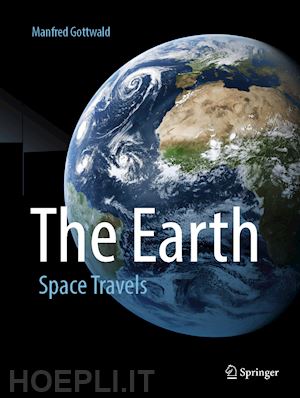
Questo prodotto usufruisce delle SPEDIZIONI GRATIS
selezionando l'opzione Corriere Veloce in fase di ordine.
Pagabile anche con Carta della cultura giovani e del merito, 18App Bonus Cultura e Carta del Docente
About 80 years ago, it was possible for the first time to confirm what modern science had suggested for centuries: Earth shows its sphericity based on a curved horizon. The following age of space flights opened other opportunities. First, our home planet could be observed from low Earth orbits, and then, a while later, even from the distance of the Moon. Interplanetary space flights even shifted our perspective out into the universe. Images sent back from many spacecraft showed how Earth and its Moon are part of the solar system.
This book is a journey away from Earth, but always looking back at it. The journey starts with balloon flights reaching the stratosphere, followed by the tedious attempts to reach space. When space flight in low Earth orbits had been achieved, frequent unmanned and manned missions covered that region. Further milestones reached geostationary orbit and the Moon. Interplanetary missions allowed us to become acquainted with large parts of the solar system. They showed us how unique our home planet Earth is. A photo from a distance of 6 billion kilometers, the famous “pale blue dot,” always reminds us of this fact.
The translation was done with the help of artificial intelligence. The author has subsequently revised the text further in an endeavour to refine the work stylistically.
Earth Views – From Fiction to Reality.- Close to Space – Every Beginning is Difficult.- Ballistic Flights – Away from Earth.- Unmanned Low Earth Orbit – Under Constant Observation.- Manned Low Earth Orbit – Beautiful Prospects.- Geostationary Orbit – A View of the Whole.- Unmanned Moon Missions – From Cosmic Proximity.- Manned Moon Missions – Men on the Moon.- Inner Lagrange Point – In Step around the Sun.- Interplanetary Travel – Visits to Our Cosmic Neighborhood.
Manfred Gottwald studied astronomy and physics at Ludwig-Maximilians-University in Munich. He received his PhD from the Technical University of Munich. In 1991, he moved to the German Aerospace Center (DLR). There, the solar system and particularly our home planet Earth became his research fields. Since 2012, when the first digital elevation model data from the TanDEM-X mission, a twin radar X-band configuration operated and controlled by DLR, became available, he has been engaged in the study of terrestrial impact structures. The digital elevation model allowed, for the first time, the publication of a topographic atlas of all impacts still existing on Earth. In September 2018, he retired from DLR but continues to work in the field of terrestrial impact structures. His numerous publications, in the form of lectures, articles, and books, cater to both the scientific community and the interested public, covering the entire universe – from its distant edge to the surface of our home planet.











Il sito utilizza cookie ed altri strumenti di tracciamento che raccolgono informazioni dal dispositivo dell’utente. Oltre ai cookie tecnici ed analitici aggregati, strettamente necessari per il funzionamento di questo sito web, previo consenso dell’utente possono essere installati cookie di profilazione e marketing e cookie dei social media. Cliccando su “Accetto tutti i cookie” saranno attivate tutte le categorie di cookie. Per accettare solo deterninate categorie di cookie, cliccare invece su “Impostazioni cookie”. Chiudendo il banner o continuando a navigare saranno installati solo cookie tecnici. Per maggiori dettagli, consultare la Cookie Policy.